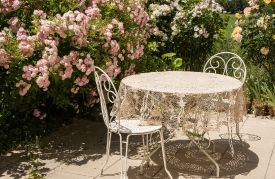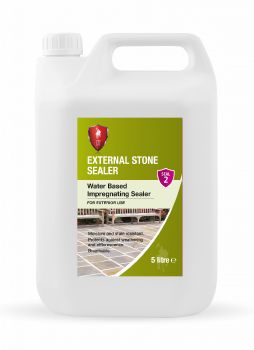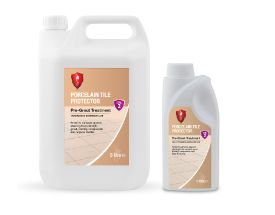
Outside areas have become so important, providing an extension to the home and, in recent months, a safe place to meet. Often, the same tile finish is used from home to garden, through bi-fold doors, creating a stunning, seamless look… but this aesthetic generally doesn’t last. Issues arise because maintenance regimes adopted indoors are rarely continued outside. While indoor tiles are sealed and regularly cleaned, patio tiles are generally ignored – apart from an occasional jet wash and sweep – and, very quickly, they become darker and dirtier. That seamless aesthetic is lost in a matter of months, but it doesn’t need to be. It’s simply a case of not stopping at the door.

The idea of adopting a regular cleaning regime for outdoor tiles may seem a little strange here in the UK. But, elsewhere in Europe, regular mopping and cleaning of outside spaces is commonplace. As our weather can be rather unpredictable, there’s perhaps an even greater need to keep on top of outdoor surfaces; it will make a big difference to the general appearance and it will reduce the need for future intensive cleaning and sealing.
How to maintain a seamless aesthetic
Step One: Protection
STONE PATIOS: External stone tiles will benefit from a protective seal, just like internal stone tiles. Treatments designed for outdoor surfaces tend to be slightly different from indoor products; rather than just protecting against water and stains, they will also protect against weather and efflorescence, and help prevent the formation of moss and mould, etc. Water-based treatments, like LTP External Stone Sealer, now offer even greater performance than traditional spirit-based products. They’re also much safer to apply, more eco-friendly and you can apply them over residual moisture, rather than having to wait for days on end until a surface is completely bone dry.
Before applying LTP External Stone Sealer, we recommend a first wash with a dilute solution of LTP Grimex (1:10). This will remove any fixing residues. The wet surface should be scrubbed, using a white pad, rinsed and left overnight to dry. LTP External Stone Sealer is then applied with a foam roller or paint brush. See the Datasheet for more information on application, coverage and preparation of older surfaces – or link to the product page and watch the Video Aid.

PORCELAIN PATIOS: Matt porcelain tiles (which are normally used outside) don’t need to be sealed in the traditional way. However, because they are generally textured (to create a non-slip surface), they can be prone to grout staining. Fixing residues and dirt become trapped in the ‘high-low’ surface, creating unslightly white marks which are hard to remove. This residue makes ongoing maintenance more difficult and potentially creates a slip hazard.
To reduce the risk of staining, a barrier treatment can be applied before grouting. We recommend LTP Porcelain Tile Protector which provides a number of benefits:
- It prevents grout and resins from taking hold.
- It makes the removal of any residues much easier, should they occur.
- Porcelain needs to be kept as wet as possible during installation, to improve and increase grout working times. The protector does this, which also aids points 1 and 2.
- A further coat applied after installation will make ongoing maintenance easier too.
Tiles should be clean and dry before applying LTP Porcelain Tile Protector. Like the stone sealer, it might be necessary to give the surface a first wash with a dilute solution of LTP Grimex, at a 1:5 dilution, using a white pad. The tiles should then be rinsed and left overnight to dry before applying the Protector.

Before grouting, LTP Porcelain Tile Protector should be applied evenly to the surface using a broad paint brush, foam roller or light pressure sprayer. Allow 30 minutes drying time and then apply a second coat. The surface should then be left to cure for a minimum of one hour before grouting or pointing. Once the grout is dry, and all residues have been removed, a further coat of Protector can be applied to the tiles and the grout joint.
How to maintain a seamless aesthetic
Step Two: A regular maintenance regime
Whilst it may not be practical to mop the patio as often as indoor tiles, it’s worth giving it a thorough clean every couple of months or so – ideally, three times during late spring/summer and a couple of times during the winter. Surfaces that are regularly cleaned will be easier to keep clean – and it will help to maintain that aesthetic.
NB. A blast with a jet wash may seem like the best method but it will only wash dirt off the tile surface, whereas as a specialist treatment will react with stubborn, ingrained residue & organic matter and help break it down. This is especially important with porous surfaces, like limestone and sandstone.
For a thorough clean, we recommend LTP Grimex for stone and porcelain tiles. Grimex can be used at different dilutions depending on the severity of staining. Tiles are washed, using a brush or garden broom, and rinsed with clean water.


For periodic cleaning of porcelain tiles, you can also use LTP Porcelain Floor Tile Cleaner inside and outside. Just dilute 2 or 3 capfuls in a bucket of warm water – or 5 on dirtier floors – wash the floor and allow to dry. This product doesn’t require rinsing.
To remove specific stains from outdoor slabs, like black spot and algae, rust or efflorescence, there are targeted treatments. These include LTP Blackspot & Algae Remover, LTP Rust Stain Remover and, for efflorescence, LTP Cement Grout & Salt Residue Remover. All three treatments are safe to use on stone and porcelain tiles. As with routine cleaning, it’s best to remove stains on a regular basis, especially black spot and algae; this will break down microspores before they colonise within the stone, and prevent slippery residue from building up on all types of tile.
For more advice and information about LTP’s range, please call 01823 666213 or email [email protected]



